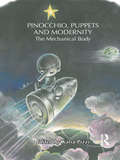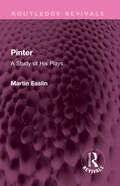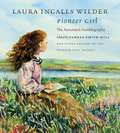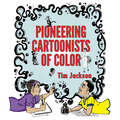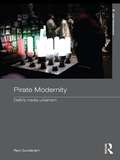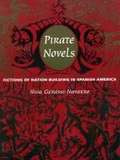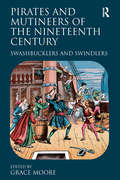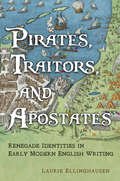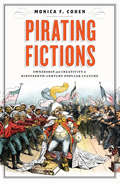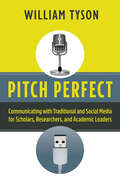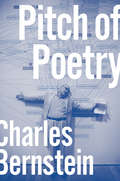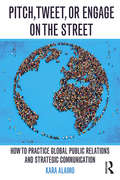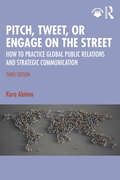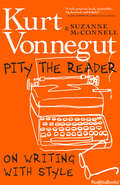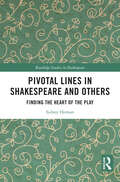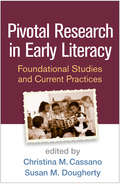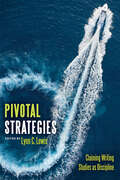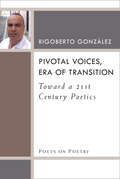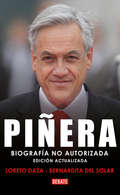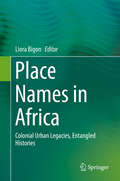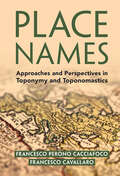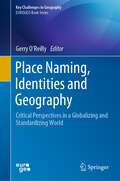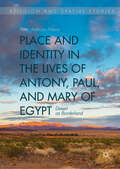- Table View
- List View
Pinocchio, Puppets, and Modernity: The Mechanical Body (Children's Literature and Culture)
by Katia PizziThis study assesses the significance of Pinocchio in the twentieth and twenty-first centuries in addition to his status as the creature of a nineteenth century traversed by a cultural enthusiasm for dummies, puppets, and marionettes. This collection identifies him as a figure characterized by a 'fluid identity,' informed with transition, difference, joie de vivre, otherness, displacement, and metamorphosis, making Pinocchio a truly modern, indeed postmodern and posthuman, cultural icon. Pinocchio, Puppets and Modernity explores this crucial and as yet little visited field, reassessing Pinocchio's genealogy and progeny, as well as illuminating both the wider context and more specific cultural manifestations of the mechanical-human interface in the domains of theatre, the fine arts, literature, radio, and even virtual reality coherently with the digital metamorphosis of our times. The wide-ranging scope of this exploration encompasses Italian, French, and English literature, dummies and marionettes in modernist and contemporary theatre, the fairytale tradition, and traditional and contemporary painting, as well as the older and newer media of radio, television, cinema, and the Internet. The diverse, comparative, and multimedia focus of this original discussion testifies to the enduring transcultural legacy of Pinocchio. Eminently sellable as a traditional cultural icon, Pinocchio is equally impactful and relevant for a globalized, multicultural, and virtual society, from Collodi to Disney and beyond. Katia Pizzi is Senior Lecturer in Italian at the Institute of Germanic & Romance Studies, School of Advanced Study, University of London. She has published volumes on cultural identities, including A City in Search of an Author (2001) and The Cultural Identities of European Cities (2010), and on children's literature and illustration.
Pinter: A Study of His Plays (Routledge Revivals)
by Martin EsslinFirst published in 1977, the third edition of Pinter is an excellent analysis of Harold Pinter and his works. Written when Pinter was only a few plays old, the book draws on several sources, including interviews with Pinter himself, to comment on Pinter’s career, his aesthetic and philosophical choices, and his oeuvre as a writer. The section devoted to his individual plays has been arranged in a chronological manner to visually represent the growth of the playwright and the relationship shared between his early and later works. Esslin, known for coining the term ‘theatre of the absurd,’ was himself an inspiration to Pinter and hence, the book records an intellectual and creative exchange between the author and his subject. The book will be of interest to students of literature, drama, history as well as to an academically inclined theatre audience.
Pioneer Girl: The Annotated Autobiography
by Laura Ingalls Wilder Pamela Smith HillFollow the real Laura Ingalls and her family as they make their way west and discover that truth is as remarkable as fiction.<P><P> Hidden away since the 1930s, Laura Ingalls Wilder s never-before-published autobiography reveals the true stories of her pioneering life. Some of her experiences will be familiar; some will be a surprise. Pioneer Girl re-introduces readers to the woman who defined the pioneer experience for millions of people around the world.<P> Through her recollections, Wilder details the Ingalls family s journey from Kansas, Missouri, Wisconsin, Minnesota, Iowa, back to Minnesota, and on to Dakota Territory sixteen years of travels, unforgettable stories, and the everyday people who became immortal through her fiction. Using additional manuscripts, diaries, and letters, Pioneer Girl: The Annotated Autobiography builds on Wilder s work by adding valuable context and explores her growth as a writer.<P> Author of an award-winning Laura Ingalls Wilder biography, editor Pamela Smith Hill offers new insights into Wilder s life and times. In an introduction, Hill illuminates Wilder s writing career and the dynamic relationship between the budding novelist and her daughter and editor, Rose Wilder Lane. Sharing the story of Wilder s original manuscript, Hill discusses the catalysts for Pioneer Girl and the process through which Wilder s story turned from an unpublished memoir into the national phenomenon of the Little House series.<P> Pioneer Girl: The Annotated Autobiography also explores the history of the frontier that the Ingalls family traversed and the culture and life of the communities Wilder lived in. This groundbreaking volume develops a fuller picture of Wilder s life and times for the millions of readers who wish to learn more about this important American author. It contains one hundred and twenty-five images, eight fully researched maps, and hundreds of annotations based on numerous primary sources, including census data, county, state, and federal records, and newspapers of the period.<P> An important historic and literary achievement, this annotated edition of Pioneer Girl provides modern readers with new insights into the woman behind the fictional classics Little House in the Big Woods, Farmer Boy, Little House on the Prairie, On the Banks of Plum Creek, By the Shores of Silver Lake, The Long Winter, Little Town on the Prairie, These Happy Golden Years, and The First Four Years.
Pioneering Cartoonists of Color
by Tim JacksonSyndicated cartoonist and illustrator Tim Jackson offers an unprecedented look at the rich yet largely untold story of African American cartoon artists. This book provides a historical record of the men and women who created seventy-plus comic strips, many editorial cartoons, and illustrations for articles. The volume covers the mid-1880s, the early years of the self-proclaimed black press, to 1968, when African American cartoon artists were accepted in the so-called mainstream.When the cartoon world was preparing to celebrate the one hundredth anniversary of the American comic strip, Jackson anticipated that books and articles published upon the anniversary would either exclude African American artists or feature only the three whose work appeared in mainstream newspapers after Dr. Martin Luther King Jr.'s assassination in 1968. Jackson was determined to make it impossible for critics and scholars to plead an ignorance of black cartoonists or to claim that there is no information on them. He began in 1997 cataloging biographies of African American cartoonists, illustrators, and graphic designers, and showing samples of their work. His research involved searching historic newspapers and magazines as well as books and "Who's Who" directories.This project strives not only to record the contributions of African American artists, but also to place them in full historical context. Revealed chronologically, these cartoons offer an invaluable perspective on American history of the black community during pivotal moments, including the Great Migration, race riots, the Great Depression, and both World Wars. Many of the greatest creators have already died, so Jackson recognizes the stakes in remembering them before this hidden yet vivid history is irretrievably lost.
Pirandello's Theatre of Living Masks
by Umberto Mariani Alice Gladstone MarianiNobel Prize-winning dramatist Luigi Pirandello is known worldwide for his innovative, complex plays. In Pirandello's Theatre of Living Masks, Umberto Mariani and Alice Gladstone Mariani offer the first new edition in nearly sixty years of six of his major works - Liola, It Is So If You Think So, Six Characters in Search of an Author, Henry IV, Each in His Own Way, and The Mountain Giants.Mariani and Mariani's translations of these texts are both vibrant and faithful to the originals, using contemporary expressions and unambiguous language to facilitate readability and comprehension. This edition also offers a critical introduction to each play's most significant characters and structures, highlighting themes and poetics as they correspond to Pirandello's entire body of work. Pirandello's Theatre of Living Masks will appeal to those already familiar with his plays and those looking to discover one of the twentieth century's great dramatists.
Pirate Modernity: Delhi's Media Urbanism (Routledge Studies in Asia's Transformations)
by Ravi SundaramUsing Delhi’s contemporary history as a site for reflection, Pirate Modernity moves from a detailed discussion of the technocratic design of the city by US planners in the 1950s, to the massive expansions after 1977, culminating in the urban crisis of the 1990s. As a practice, pirate modernity is an illicit form of urban globalization. Poorer urban populations increasingly inhabit non-legal spheres: unauthorized neighborhoods, squatter camps and bypass legal technological infrastructures (media, electricity). This pirate culture produces a significant enabling resource for subaltern populations unable to enter the legal city. Equally, this is an unstable world, bringing subaltern populations into the harsh glare of permanent technological visibility, and attacks by urban elites, courts and visceral media industries. The book examines contemporary Delhi from some of these sites: the unmaking of the citys modernist planning design, new technological urban networks that bypass states and corporations, and the tragic experience of the road accident terrifyingly enhanced by technological culture. Pirate Modernity moves between past and present, along with debates in Asia, Africa and Latin America on urbanism, media culture, and everyday life. This pioneering book suggests cities have to be revisited afresh after proliferating media culture. Pirate Modernity boldly draws from urban and cultural theory to open a new agenda for a world after media urbanism.
Pirate Novels: Fictions of Nation Building in Spanish America
by Nina Gerassi-NavarroIn Pirate Novels Nina Gerassi-Navarro examines an overlooked genre to reveal how history and fiction blend to address important isuses of nation building in nineteenth-century Spanish America. In the figure of the pirate, bold and heroic to some, cruel and criminal to others, she reveals an almost ideal character that came to embody the spirit of emerging nationhood and the violence associated with the struggle to attain it. Beginning with an overview of the history of piracy, Gerassi-Navarro traces the historical icon of the pirate through colonial-era chronicles before exploring a group of nineteenth-century Mexican, Colombian, and Argentine novels. She argues that the authors of these novels, in their reconstructions of the past, were less interested in accurate representations than in using their narratives to discuss the future of their own countries. In reading these pirate narratives as metaphors for the process of nation building in Spanish America, Gerassi-Navarro exposes the conflicting strains of a complex culture attempting to shape that future. She shows how these pirate stories reflect the on-going debates that marked the consolidation of nationhood, as well as the extent to which the narratives of national identity in Spanish America are structured in relation to European cultures, and the ways in which questions of race and gender were addressed. Providing new readings of the cultural and political paradigms that marked the literary production of nineteenth-century Spanish America, Pirate Novels uniquely expands the range of texts usually examined in the study of nation-building. It will interest literary scholars generally as well as those engaged in Latin American, colonial, and postcolonial studies.
Pirates and Mutineers of the Nineteenth Century: Swashbucklers and Swindlers
by Grace MooreThe first volume devoted to literary pirates in the nineteenth century, this collection examines changes in the representation of the pirate from the beginning of the nineteenth century through the late Victorian period. Gone were the dangerous ruffians of the eighteenth-century novel and in their place emerged a set of brooding and lovable rogues, as exemplified by Byron's Corsair. As the contributors engage with acts of piracy by men and women in the literary marketplace as well as on the high seas, they show that both forms were foundational in the promotion and execution of Britain's imperial ambitions. Linking the pirate's development as a literary figure with the history of piracy and the making of the modern state tells us much about race, class, and evolving gender relationships. While individual chapters examine key texts like Treasure Island, Dickens's 1857 'mutiny' story in Household Words, and Peter Pan, the collection as a whole interrogates the growth of pirate myths and folklore throughout the nineteenth century and the depiction of their nautical heirs in contemporary literature and culture.
Pirates, Traitors, and Apostates: Renegade Identities in Early Modern English Writing
by Laurie EllinghausenExamining tales of notorious figures in Renaissance England, including the mercenary Thomas Stukeley, the Barbary corsair John Ward, and the wandering adventurers the Sherley brothers, Laurie Ellinghausen sheds new light on the construction of the early modern renegade and its depiction in English prose, poetry, and drama during a period of capitalist expansion. Unlike previous scholarship which has focused heavily on positioning rogue behaviour within the dialogue of race, gender, religion, and nationalism, Pirates, Traitors, and Apostates: Renegade Identities in Early Modern England shows how domestic issues of class and occupation exerted a major influence on representations of renegades, and heightened their appeal to the diverse audiences of early modern England. By looking at renegade tales from this perspective, Ellinghausen reveals a renegade, who, despite being stigmatized as an outsider, becomes a major profiteer during the period of early expansion, and ultimately a key figure in the creation of a national English identity.
Pirating Fictions: Ownership and Creativity in Nineteenth-Century Popular Culture (Victorian Literature and Culture Series)
by Monica F. CohenTwo distinctly different meanings of piracy are ingeniously intertwined in Monica Cohen's lively new book, which shows how popular depictions of the pirate held sway on the page and the stage even as their creators were preoccupied with the ravages of literary appropriation. The golden age of piracy captured the nineteenth-century imagination, animating such best-selling novels as Treasure Island and inspiring theatrical hits from The Pirates of Penzance to Peter Pan. But the prevalence of unauthorized reprinting and dramatic adaptation meant that authors lost immense profits from the most lucrative markets. Infuriated, novelists and playwrights denounced such literary piracy in essays, speeches, and testimonies. Their fiction, however, tells a different story.Using landmarks in copyright history as a backdrop, Pirating Fictions argues that popular nineteenth-century pirate fiction mischievously resists the creation of intellectual property in copyright legislation and law. Drawing on classic pirate stories by such writers as Walter Scott, James Fenimore Cooper, Robert Louis Stevenson, and J. M. Barrie, this wide-ranging account demonstrates, in raucous tales and telling asides, how literary appropriation was celebrated at the very moment when the forces of possessive individualism began to enshrine the language of personal ownership in Anglo-American views of creative work.
Pitch Perfect: Communicating with Traditional and Social Media for Scholars, Researchers, and Academic Leaders
by William TysonThis book is intended for scholars, researchers, and academic leaders who have a passion to share their knowledge outside their classroom, laboratory, or institution; who want to make a difference; and who believe that the information they possess and ideas they offer are important for a wider public. Pitch Perfect is a practical guide to communicating your knowledge and research to broader audiences. How do you get yourself heard amid the volume of news and information in today’s 24-hour news cycle, and get your message across in an environment where blogs and Twitter vie with traditional media? To break through, you need to amplify your ideas and make them relevant for a wider public audience.Bill Tyson – who has been successfully advising scholars and academic leaders on media relations for over 30 years – shows you how to undertake early and thoughtful communications planning, understand the needs and workings of the media, both traditional and digital, and tell your story in a way that will capture your audience. Bill Tyson is strategic in his advice, no less so when discussing how to engage with such social media as blogs, Facebook, Twitter, YouTube, podcasts or wikis.Whether you are working on research or a new initiative that has public implications, or have a story that deserves wide telling; whether you want to address funders’ requests for communications plans to promote the programs they are supporting, or whether you want to know how to publicize your new book; this practical guide offers insider advice – complete with case studies – on how to communicate your message. An appendix lists key media in North America, Australia, and the UK.
Pitch of Poetry
by Charles BernsteinPraised in recent years as a "calculating, improvisatory, essential poet" by Daisy Fried in the New York Times, Charles Bernstein is a leading voice in American literary theory. Pitch of Poetry is his irreverent guide to modernist and contemporary poetics. Subjects range across Holocaust representation, Occupy Wall Street, and the figurative nature of abstract art. Detailed overviews of formally inventive work include essays on--or "pitches" for--a set of key poets, from Gertrude Stein and Robert Creeley to John Ashbery, Barbara Guest, Larry Eigner, and Leslie Scalapino. Bernstein also reveals the formative ideas behind the magazine L=A=N=G=U=A=G=E. The final section, published here for the first time, is a sweeping work on the poetics of stigma, perversity, and disability that is rooted in the thinking of Edgar Allan Poe, Emily Dickinson, Ralph Waldo Emerson, and William Blake. Pitch of Poetry makes an exhilarating case for what Bernstein calls echopoetics: a poetry of call and response, reason and imagination, disfiguration and refiguration.
Pitch, Tweet, or Engage on the Street: How to Practice Global Public Relations and Strategic Communication
by Kara AlaimoPitch, Tweet, or Engage on the Street offers a modern guide for how to practice public relations and strategic communication around the globe. Drawing upon interviews with public relations professionals in over 30 countries as well as the author’s own experience as a global public relations practitioner in the United Nations and in U.S. President Barack Obama’s administration, this book explains how to adapt public relations strategies, messages, and tactics for countries and cultures around the globe. The book begins by explaining key cultural differences which require practitioners to adapt their approaches, before discussing how to build and manage a global public relations team and how to practice global public relations on behalf of corporations, non-profit organizations, and governments. Then, the book takes readers on a tour of the world, explaining how to adapt their campaigns for Asia-Pacific, Europe, the Middle East, the Americas, and Sub-Saharan Africa. Along the way, readers are introduced to practitioners around the globe and case studies of particularly successful campaigns – from a public relations "siege" that successfully ended an epidemic of violence in Kenya to the remarkable P.R. strategy adopted by Bordeaux wineries in China that led to a staggering 26,900 percent increase in sales.
Pitch, Tweet, or Engage on the Street: How to Practice Global Public Relations and Strategic Communication
by Kara AlaimoThe second edition of Pitch, Tweet, or Engage on the Street offers a modern guide for how to adapt public relations strategies, messages, and tactics for countries and cultures around the globe. Drawing on interviews with public relations professionals in over 30 countries as well as the author’s own experience, the book explains how to build and manage a global public relations team, how to handle global crisis communication, and how to practice global public relations on behalf of corporations, non-profit organizations, and governments. It takes readers on a tour of the world, explaining how to adapt their campaigns for Asia-Pacific, Europe, the Middle East, the Americas, and Sub-Saharan Africa. Along the way, readers are introduced to practitioners around the globe and case studies of particularly successful campaigns. This new edition includes updates to country profiles to reflect changes in each local context, as well as expanded coverage of social media and the role of influencer engagement, and a brand-new chapter on global crisis communication. The book is ideal for graduate and upper-level undergraduate public relations students, as well as practitioners in intercultural markets.
Pitch, Tweet, or Engage on the Street: How to Practice Global Public Relations and Strategic Communication
by Kara AlaimoThe third edition of Pitch, Tweet, or Engage on the Street is an updated guide to practicing global public relations and strategic communication, preparing professionals to craft and implement international and intercultural communications campaigns.Drawing on the global literature and informed by interviews with more than 75 top practitioners from around the world, this book gives readers essential background and practical guidance to be competent public relations practitioners across countries and cultures. Ethical principles are woven throughout the text and attention is given to communications practices for corporations, non-profit organizations, and governments. Key updates to this edition include new case studies highlighting best practices in countries around the globe as well as updated information on best practices in different countries.This third edition is an essential resource for graduate and upper-level undergraduate communication and public relations students as well as practitioners in intercultural markets.Online resources for this edition include video interviews with PR professionals, lecture slides, and a guide for instructors. Please visit www.routledge.com/9781032511221
Pity the Reader: On Writing with Style
by Kurt Vonnegut Jr. Suzanne McConnell&“A rich, generous book about writing and reading and Kurt Vonnegut as writer, teacher, and friend . . . Every page brings pleasure and insight.&”—Gail Godwin, New York Times bestselling author Here is an entirely new side of Kurt Vonnegut, Vonnegut as a teacher of writing. Of course he&’s given us glimpses before, with aphorisms and short essays and articles and in his speeches. But never before has an entire book been devoted to Kurt Vonnegut the teacher. Here is pretty much everything Vonnegut ever said or wrote having to do with the writing art and craft, altogether a healing, a nourishing expedition. His former student, Suzanne McConnell, has outfitted us for the journey, and in these 37 chapters covers the waterfront of how one American writer brought himself to the pinnacle of the writing art, and we can all benefit as a result. Kurt Vonnegut was one of the few grandmasters of American literature, whose novels continue to influence new generations about the ways in which our imaginations can help us to live. Few aspects of his contribution have not been plumbed—fourteen novels, collections of his speeches, his essays, his letters, his plays—so this fresh view of him is a bonanza for writers and readers and Vonnegut fans everywhere. &“Part homage, part memoir, and a 100% guide to making art with words, Pity the Reader: On Writing with Style is a simply mesmerizing book, and I cannot recommend it highly enough!&”—Andre Dubus III, #1 New York Times bestselling author &“The blend of memory, fact, keen observation, spellbinding descriptiveness and zany characters that populated Vonnegut&’s work is on full display here.&”—James McBride, National Book Award-winning author
Pivotal Lines in Shakespeare and Others: Finding the Heart of the Play (Routledge Studies in Shakespeare)
by Sidney HomanPivotal Lines in Shakespeare and Others defines a pivotal line as "a moment in the script that serves as a pathway into the larger play … a magnet to which the rest of the play, scenes before and after, adheres." Homan offers his personal choices of such lines in five plays by Shakespeare and works by Beckett, Brecht, Pinter, Shepard, and Stoppard. Drawing on his own experience in the theatre as actor and director and on campus as a teacher and scholar, he pairs a Shakespearean play with one by a modern playwright as mirrors for each other. One reviewer calls his approach "ground-breaking." Another observes that his "experience with the particular plays he has chosen is invaluable" since it allows us to find "a wedge into such iconic texts." Academics and students alike will find this volume particularly useful in aiding their own discovery of a pivotal line or moment in the experience of reading about, watching, or performing in a play.
Pivotal Research in Early Literacy: Foundational Studies and Current Practices
by Christina M. Cassano Susan M. Dougherty Joanne Knapp-Philo Heidi Anne Mesmer M. M. Rose-McCullyThis reader-friendly text examines the key foundational studies in early literacy. It addresses such essential questions as how research informs current practices and where the field still needs to go to provide the best learning opportunities for all children. Each chapter describes the methods and findings of one to five seminal studies, critically assesses their long-term impact on practice and policy, and offers takeaways for the classroom. Leading authorities--including several authors of the original pivotal studies--cover 12 essential aspects of language development, literacy development, and home and community literacy experiences in PreK–2.
Pivotal Strategies: Claiming Writing Studies as Discipline
by Lynn C. LewisPivotal Strategies examines the rhetorical contexts and motivations that determine how and why people choose writing studies as a discipline, especially as the field begins to take more seriously an antiracist imperative that requires more conscious listening and promotion of work from scholars representing traditionally underrepresented voices. Because undergraduate degrees in writing studies are relatively new, claiming the discipline has required reinvention and revision at personal and professional levels far different than any other discipline. Suspicions about the viability of the discipline linger in many departments and universities, as well as outside the academy, leading writing studies scholars to develop innovative strategies to deal with covertly hostile attitudes. Within the collection, contributors name explicit claiming strategies from the discipline’s beginnings to the contemporary moment, locating opportune spaces, negotiating identities and fostering resilience, and developing allegiances by foregrounding their embodiment as underrepresented members of academia through a commitment to social justice and equity. Responding to current conversations on the worth of education with honest stories about the burdens and joys of becoming and being an academic, Pivotal Strategies features a spectrum of voices across racial, gender, class, and age categories. This collection not only makes the discipline more visible but also helps map the contemporary state of writing studies.
Pivotal Voices, Era of Transition: Toward a 21st Century Poetics
by Rigoberto GonzalezPivotal Voices, Era of Transition gathers Rigoberto González’s most important essays and book reviews, many of which consider the work of emerging poets whose identities and political positions are transforming what readers expect from contemporary poetry. A number of these voices represent intersectional communities, such as queer writers of color like Natalie Díaz, Danez Smith, Ocean Vuong, and Eduardo C. Corral, and many writers, such as Carmen Giménez Smith and David Tomás Martínez, have deep connections to their Latino communities. Collectively, these writers are enriching American poetry to reflect a more diverse, panoramic, and socially conscious literary landscape. Also featured are essays on the poets’ literary ancestors—including Juan Felipe Herrera, Alurista, and Francisco X. Alarcón—and speeches that address the need to leverage poetry as agency. This book fills a glaring gap in existing poetry scholarship by focusing exclusively on writers of color, and particularly on Latino poetry. González makes important observations about the relevance, urgency, and exquisite craft of the work coming from writers who represent marginalized communities. His insightful connections between the Latino, African American, Asian American, and Native American literatures persuasively position them as a collective movement critiquing, challenging, and reorienting the direction of American poetry with their nuanced and politicized verse. González’s inclusive vision covers a wide landscape of writers, opening literary doors for sexual and ethnic minorities.
Piñera. Biografía no autorizada
by María Loreto DazaLa edición actualizada de una biografía que expuso las contradicciones del nuevamente candidato a la presidencia de Chile Esta elogiada biografía #que se basa en más de cien entrevistas a familiares, amigos y adversarios#, repasa los entretelones más importantes de la vida del ex presidente y desgrana los sucesos más polémicos en los que se ha visto envuelto: el Banco de Talca, el #Piñeragate#, o los flancos que debió sortear al inicio de su presidencia con la venta de sus acciones de Blanco y Negro, LAN y Chilevisión. Con un nuevo capítulo que abarca la reconstrucción del país luego del terremoto de 8,8° en la escala de Richter ocurrido el 27 de febrero de 2010, la política de austeridad impulsada por su gobierno, las movilizaciones estudiantiles, el rescate de los treinta y tres mineros, la salida de los ministros #técnicos# y el importante crecimiento económico que marcó su gestión, las autoras de este libro #titulado anteriormente Piñera. Historia de un ascenso#, vuelven a perfilar a este controvertido empresario y político chileno, que con el transcurso de los años, y luego de aprender tanto de los éxitos y fracasos de su gobierno, #ya no pretende ganar siempre#.
Place Names in Africa
by Liora BigonThis volume examines the discursive relations between indigenous, colonial and post-colonial legacies of place-naming in Africa in terms of the production of urban space and place. It is conducted by tracing and analysing place-naming processes, particularly in sub-Saharan Africa during colonial times (British, French, Belgian, Portuguese), with a considerable attention to both the pre-colonial and post-colonial situations. By combining in-depth area studies research - some of the contributions are of ethnographic quality - with colonial history, planning history and geography, the authors intend to show that culture matters in research on place names. This volume goes beyond the recent understanding obtained in critical studies of nomenclature, normally based on lists of official names, that place naming reflects the power of political regimes, nationalism, and ideology.
Place Names: Approaches and Perspectives in Toponymy and Toponomastics
by Francesco Perono Cacciafoco Francesco CavallaroWhat are place names? From where do they originate? How are they structured? What do they signify? How important are they in our life? This groundbreaking book explores these compelling questions and more by providing a thorough introduction to the assumptions, theories, terminology, and methods in toponymy and toponomastics – the studies of place names, or toponyms. It is the first comprehensive resource on the topic in a single volume, and explores the history and development of toponyms, focusing on the conceptual and methodological issues pertinent to the study of place names around the world. It presents a wide range of examples and case studies illustrating the structure, function, and importance of toponyms from ancient times to the present day. Wide ranging yet accessible, it is an indispensable source of knowledge for students and scholars in linguistics, toponymy and toponomastics, onomastics, etymology, and historical linguistics.
Place Naming, Identities and Geography: Critical Perspectives in a Globalizing and Standardizing World (Key Challenges in Geography)
by Gerry O’ReillyThis book presents research on geographical naming on land and sea from a wide range of standpoints on: theory and concepts, case studies and education. Space and place naming or toponymy has a long tradition in the sciences and a renewed critical interest in geography and allied disciplines including the humanities. Place: location and cartographical aspects, etymology and geo-histories so salient in past studies, are now being enhanced from a range of radical perspectives, especially in a globalizing, standardizing world with Googlization and the consequent ‘normalization’ of place names, perceptions and images worldwide including those for marketing purposes. Nonetheless, there are conflicting and contesting voices. The interdisciplinary research is enhanced with authors from regional, national and international toponymy-related institutions and organizations including the UNGEGN, IGU, ICA and so forth.
Place and Identity in the Lives of Antony, Paul, and Mary of Egypt: Desert as Borderland (Religion and Spatial Studies)
by Peter Anthony MenaIn this book, Peter Anthony Mena looks closely at descriptions of space in ancient Christian hagiographies and considers how the desert relates to constructions of subjectivity. By reading three pivotal ancient hagiographies—the Life of Antony, the Life of Paul the Hermit, and the Life of Mary of Egypt—in conjunction with Gloria Anzaldúa’s ideas about the US/Mexican borderlands/la frontera, Mena shows readers how descriptions of the desert in these texts are replete with spaces and inhabitants that render the desert a borderland or frontier space in Anzaldúan terms. As a borderland space, the desert functions as a device for the creation of an emerging identity in late antiquity—the desert ascetic. Simultaneously, the space of the desert is created through the image of the saint. Literary critical, religious studies, and historical methodologies converge in this work in order to illuminate a heuristic tool for interpreting the desert in late antiquity and its importance for the development of desert asceticism. Anzaldúa’s theories help guide a reading especially attuned to the important relationship between space and subjectivity.
